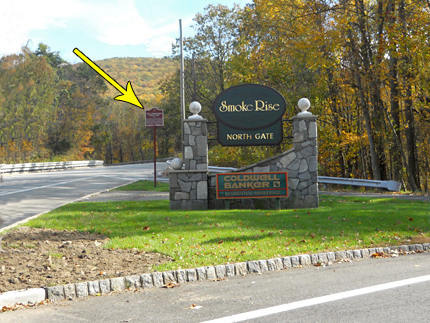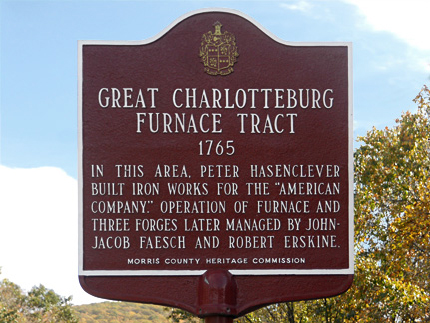



Great Charlotteburg Furnace Tract Marker
Rte. 23 South
Sign is next to the entrance for Smoke Rise
Map / Directions to the Great Charlotteburg Furnace Tract
A historic sign at the Smoke Rise entrance on Rte. 23 marks the area of what was once the Great Charlotteburg Furnace Tract. Iron works were built here in 1765 by a man named Peter Hasenclever. He named the site in honor of Queen Charlotte, the wife of King George III. The tract took up 6.583 acres of land (just over 10 square miles), and consisted of many buildings, employing many workers. The following inventory of structures built here in 1765-1766 gives an idea of just how big an operation the iron works were:
1 Furnace
2 Forges, with 8 fires 80' long and 45' broad
1 Stamping Mill
3 Charcoal Houses
2 Blacksmith Shops
7 Frame Houses with Bricks
37 Log Houses
3 Store House
2 Saw Mills
3 Stables
1 Carpenter's Shop
2 Reservoirs
3 Ponds
5 Bridges
The furnace was located to the northwest of here, on the Pequannock River. A forge known as the Middle Forge was located on the river approximately 200 yards southeast from the sign. Another forge, known as the Lower Forge, was located about a mile southeast along the river.
From 1769 - 1772, John Jacob Faesch was the manager of these iron works. He subsequently ran an iron works in Mount Hope, which would produce ammunition during the Revolutionary War for George Washington's army. The next manager, Robert Erskine, would also go on to play an important role in the Revolutionary War. In 1777 Erskine was commissioned Geographer and Surveyor General of the Continental Army, and he is known as "George Washington's mapmaker."
The details about the history and use of the Great Charlotteburg Furnace Tract itself during the Revolutionary War are sketchy and uncertain. It appears that at least early in the war it was in used in the production of materials for the American army. By 1783, the year the Treaty of Paris ended the war, the Charlotteburg iron works are believed to have been abandoned. It appears that the furnace met a violent end at some time during the war, and that it may have been destroyed by Tories (Americans who sided with the British in the Revolutionary War) to keep it from being useful to the American army. [1]
An April 27, 1779 raid near the Charlotteburg iron work was reported two weeks later in a New Jersey Journal article, which stated that the raiders began with a robbery at Hibernia and then continued to the Charlotteburg area: [2]
"They went from that to Doctor Jonothan Chuver's, near Charlotburg [sic] iron-works, with an intent to murder him, having discovered on them sometime before, having met them in a wood between there and Long-Pond. While they were surrounding his house, he made his escape out a window; they fired at him, but missed him; he ran six or seven miles with no other clothes other than his shirt, and alarmed the county as he went. They plundered his house, threatened to murder his wife, made her go down on her knees twice and beg for her life. - There are parties of the militia in quest for them, and it is to be hoped the spirited true sons of liberty will turn out and scour the woods 'till they are detected, that they may get their just deserts."
1. ^ My main source for information on the Great Charlotteburg Furnace Tract was:
Lucy A. Meyer Kinnelon: A History / Where the Future is Enriched by the Past (Kinnelon NJ, Kinnelon Bicentennial Committee, 1976) p.144 -171.
Meyer's account of the history of the Great Charlotteburg Furnace Tract is very well written. It goes into detail about various aspects of the forges, and iron in this area. It is recommended to those looking for more information about the Charlotteburg Furnace tract. Unfortunately, the book is out of print, and copies may be hard to locate. It is not currently available anywhere digitized online. Copies are available at the Kinnelon Public Library and at some other New Jersey libraries.• The inventory of buildings and structures appears on page 148 of Meyer's book. She states that this list appeared in a book by Peter Hasenclever, The Remarkable Case of Peter Hasenclever, Merchant, published in London in 1773, and that it is a listing "of the buildings and structures erected there between May 1, 1765 and November 1766."
• On pages 164-167, Meyer explores possible explanations for the destruction of the iron works, stating "Conjectures about who destroyed the works are numerous with perhaps the Tories holding preference." She discusses several theories on the matter, referencing the work of several others, including Frank Malone.
2. ^ William Nelson, editor Archives of the State of New Jersey, Second Series, Vol III (Documents Relating to the Revolutionary History of the State of New Jersey / Extracts from American Newspapers relating to New Jersey) (Trenton: John L. Murphy Publishing Company, 1906) p.347
Available to be read at Google Books here